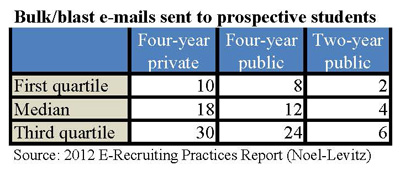enrollment
Seven steps for creating a college marketing and communication plan

Note: An updated version of this article was published in October, 2015. Click here to view the article: Eight steps for creating a college marketing and communication plan.
As student search behavior has shifted from the traditional funnel to a much more chaotic, anonymous “secret shopper” model, campuses may be unsure how to adapt their marketing plans to keep up with this change. And with so many electronic communication tools available, do traditional marketing methods still have relevance today? In fact, is “marketing” still a vital part of student recruitment?
To answer the last question first, campus marketing may be more important than ever. With more students applying and more competition from other colleges and universities, strategic marketing can make an institution stand out from its competition and put it in a strong position when prospective students do make contact. While new marketing methods and communication technologies need to be integrated into campus campaigns, traditional marketing methods still provide a lot of value when used properly.
Strong marketing and communication plans begin with an understanding of the institutional image and brand. Branding is generally an institutionwide initiative that involves university relations and enrollment management (at the very least) and should also be part of institutional strategic planning initiatives or discussions. While branding includes the development of consistent, uniform visual images (i.e., logo, standard colors, and fonts) and often a phrase or tag line, it is much more. Branding is what an institution is known for or wants to be known for–what makes it unique and distinctive. For branding to be effective in new student recruitment, an institution must continually assess how to deliver on the promise of its brand. For example, if a brand communicates “student success is our business,” then graduation rates must be well above average, retention initiatives must permeate institutional planning priorities, and alumni successes must be well tracked and documented.
Messaging involves the expression of key strengths that speak to the institution brand and may include some targeted messages for selected audiences. Messaging helps to translate why the brand has value for the audience. Unfortunately, many colleges miss the mark when it comes to selling value. The focus of the key messages tends to be more about the atmosphere of campus (student life, religious affiliation, facilities, for example) than on the actual product—the academic experience and related outcomes.
Once the key messages have been identified, the challenging task of communicating them to prospective students and their families begins. Building effective communication plans for today’s prospective students can be daunting. While it is clear that students use many forms of technology to communicate, including Web, e-mail, social media, and texting, our research also suggests that they still rely on written communication as well. In the forthcoming 2012 Noel-Levitz E-Expectations research report (due in July), 71 percent of students reported that printed publications and letters were an effective way for them to learn about a school’s academic program offerings.
One common misperception is that marketing ends when a student is admitted. This is a mistake, especially with students able and willing to apply to more institutions than they did before the advent of online applications and the common application. Effective communication plans should be integrated with the recruitment process, begin at the prospective student stage, and continue until the student is enrolled. Even after students have made a deposit, keep communicating with them and creating compelling reasons for them to see their enrollment all the way through.
Marketing plans differ from institution to institution, but here are seven strategies that can help campuses build strong, effective marketing efforts:
1. Create a five- to seven-piece communication flow that builds and sustains interest in the institution. This flow should include targeted messages by student population and focus on the key marketing messages of the institution, with particular attention paid to academic outcomes.
2. Build messaging around the marketing of specific academic programs and the results of those programs in terms of job and graduate school placements, faculty as teachers, and faculty who take time to help students. Specific tactics could include developing Web and print collateral that contain information on the program and its points of difference.
3. Enhance the Web presence, including the development of compelling pages that speak to the quality of academic programs and information on affordability. This should include a scholarship and tuition net cost calculator.
4. Create a comprehensive communication plan for parents of prospective students. Include messages that focus on quality academic programs, faculty as exceptional teachers, and the cost of attendance/scholarships/affordability.
5. Develop a distinctive post-acceptance/yield communications plan designed to build commitment to the university among admitted students, including those who have confirmed their intent to enroll. This should include messages to prospective students that outline next steps in the enrollment process and reinforce their decision to attend.
6. Increase the number of inquiries with e-mail addresses and implement an outbound electronic correspondence system designed to augment and enhance direct mail communications. In the new 2012 Noel-Levitz research report on e-recruitment practices, campuses were asked the question, “About how many bulk/blast e-mails does a typical prospective student receive from your institution over the course of a recruitment cycle?”
As you can see in this graphic here, the number has been on the rise across all institution types.
7. Support the written and electronic communication plan with a telecounseling effort, using the student’s cell phone. In the same 2012 e-recruitment practices report mentioned above, respondents were also asked, “Do you collect cell/mobile numbers from your prospective students?” Here are the most current results of campuses that said they did collect those numbers:
- Four-year privates: 92%
- Four-year publics: 74%
- Two-year publics: 96%
Those numbers have increased every year that Noel-Levitz has asked that question (click here to see the trend).
What marketing and communication mix is right for your campus? That can be a daunting question for many institutions. I’d be happy to offer my recommendations—just send me an e-mail with your questions. Just remember to keep communicating, keep targeting, and keep doing everything you can to connect with students and build a relationship with them through your marketing and communications.
